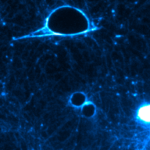Lien vers Pubmed [PMID] – 26382731
BMC Biotechnol. 2015 Sep;15:86
BACKGROUND: Botulism is a naturally occurring disease, mainly caused by the ingestion of food contaminated by the botulinum neurotoxins (BoNTs). Botulinum neurotoxins are the most lethal. They are classified among the six major biological warfare agents by the Centers for Disease Control. BoNTs act on the cholinergic motoneurons, where they cleave proteins implicated in acetylcholine vesicle exocytosis. This exocytosis inhibition induces a flaccid paralysis progressively affecting all the muscles and generally engendering a respiratory distress. BoNTs are also utilized in medicine, mainly for the treatment of neuromuscular disorders, preventing large scale vaccination. Botulism specific treatment requires injections of antitoxins, usually of equine origin and thus poorly tolerated. Therefore, development of human or human-like neutralizing antibodies is of a major interest, and it is the subject of the European framework project called “AntiBotABE”.
RESULTS: In this study, starting from a macaque immunized with the recombinant heavy chain of BoNT/A1 (BoNT/A1-HC), an immune antibody phage-display library was generated and antibody fragments (single chain Fragment variable) with nanomolar affinity were isolated and further characterized. The neutralization capacities of these scFvs were analyzed in the mouse phrenic nerve-hemidiaphragm assay.
CONCLUSIONS: After a three-round panning, 24 antibody fragments with affinity better than 10 nM were isolated. Three of them neutralized BoNT/A1 efficiently and two cross-neutralized BoNT/A1 and BoNT/A2 subtypes in the mouse phrenic nerve-hemidiaphragm assay. These are the first monoclonal human-like antibodies cross-neutralizing both BoNT/A1 and BoNT/A2. The antibody A1HC38 was selected for further development, and could be clinically developed for the prophylaxis and treatment of botulism.

